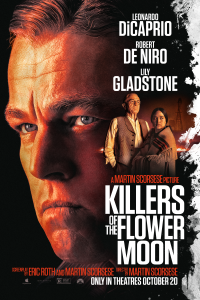
“Killers of the Flower Moon”
(USA)
Metacritic (8/10), Letterboxd (4/5), Imdb.com (8/10), TMDB.com (4/5)
The importance of addressing (and attempting to correct) gross injustices can’t be overemphasized, and that’s the key objective behind writer-director Martin Scorsese’s latest release. This fact-based saga chronicles attempts by unscrupulous, two-faced White swindlers clandestinely (and sometimes quite brazenly) seeking to steal the considerable assets of wealthy Osage Indians in Oklahoma in the 1920s after oil is discovered on their land. This tragic tale explores the depths that these immoral criminals would go to (including murder) in the name of unabashed greed, efforts ironically spearheaded by the local, smiling, allegedly well-meaning sheriff (Robert DeNiro) with the help of his dimwitted nephew (Leonardo DiCaprio), especially in their scheme to shamelessly pilfer the wealth of the accomplice’s own wife (Lily Gladstone). The sweeping scope of this offering is indeed impressive, effectively brought to life by the fine performances of the three principals and an excellent ensemble of supporting players. And the stellar cast is backed by proficiently executed work in an array of technical areas, including production design, writing, cinematography and the original background score, making for a gorgeous picture to look at, all of which have earned “Flower Moon” a boatload of awards season nominations, with more undoubtedly to follow. However, the runtime of 3:26:00 – with no intermission – is a challenge to manage, even for the most patient and tolerant moviegoer. I streamed it, watching it in two parts, almost as if it were more of a TV miniseries than a standalone film, the only way I could effectively see myself getting through it. This handling of the story, in my opinion, represents something of a significant miscalculation by the filmmaker and the film editing staff – either cut the picture (which could have been done without losing much) or add a much-needed break partway through (which could have been accomplished without inhibiting the story’s continuity). In my view, I believe that the second half was far better and more compelling than the first and that some of the narrative’s more incidental detail could have easily been dispensed with without affecting the overall quality of the release. Still, that aside, it’s obvious that this project was a labor of love for the director, one with a clear vision of what it wanted to say in relating an important and little-known story of injustice in a nation that professes to be a staunch champion of truth and virtue, and, for that, we should be thankful for the enlightenment provided here. This unconventional take on the Western may not feature the traditional cinematic interpretation of cowboys and Indians, but it nevertheless sets the record straight about who the real villains are, at least in this story, a lesson from which we can all learn.




Leave A Comment